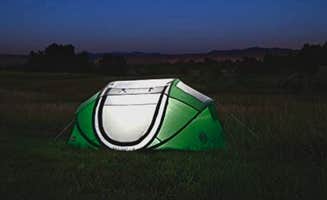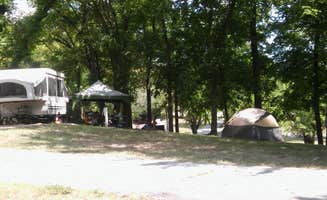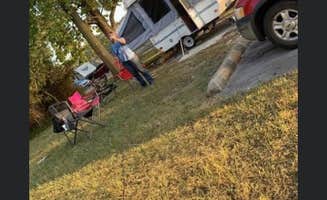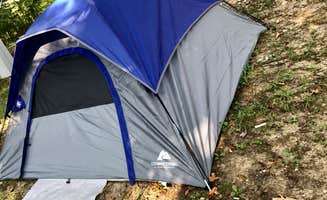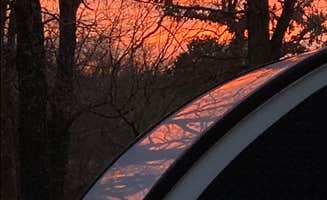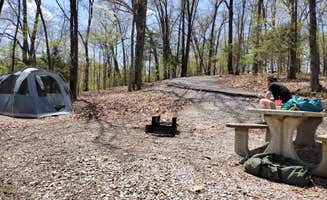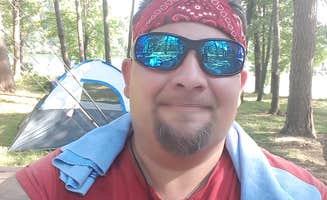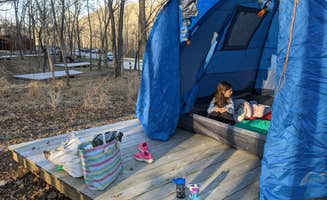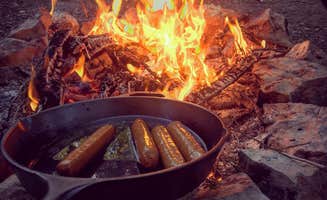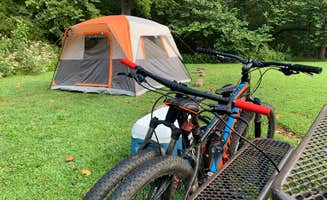Beaver Lake dominates the camping landscape around Springdale, Arkansas with over 450 miles of shoreline and elevations ranging from 1,100 to 1,300 feet. Most campgrounds in this region operate in the Corps of Engineers style with gravel pads, basic amenities, and water access points. Fall brings temperatures between 60-75°F and spectacular foliage displays, while summer humidity often exceeds 80%.
What to do
Hiking at Blowing Springs: Blowing Springs RV Park provides direct access to the Back 40 trail system. "We get on our bikes and ride all day and then come back and enjoy the peaceful campground," notes one visitor to Blowing Springs RV Park. The park features an arboretum, small caves, and connecting trails to the larger mountain biking network.
Explore historical structures: Lake Wedington, 15 miles from Springdale, offers more than just water recreation. "This place reminded me of Lake Lure from 'Dirty Dancing' with its historical buildings and beautiful lake," reports one camper at Lake Wedington. The 1.5-mile loop trail around the lake passes through wooded areas with various wildlife viewing opportunities.
Water recreation: Many campgrounds provide boat ramps, swimming areas, and fishing access. "The campground is close to Rogers, Arkansas if you need any supplies. I used it as a gateway to head in to the Ozark National Forest which is about 1.5 hours away," mentions a visitor to Horseshoe Bend. Boat rentals at several marinas include pontoons, kayaks, and fishing boats.
What campers like
Level sites with water proximity: Not all sites are created equal, and campers note significant variations in site levelness. "The campground is broken into small sections, traffic is limited near the sites which adds to the peacefulness. The sunrise comes up over the lake and is a must see," explains a visitor to Prairie Creek Campground.
Uncrowded alternatives: While popular sites fill quickly, smaller campgrounds provide quieter experiences. "Small and usually very quiet my family spends time here every year," says a camper at War Eagle Campground. This lesser-known location features only 26 sites, making it significantly less crowded than larger facilities.
Off-season camping: For those seeking solitude, winter camping offers unique advantages. "Came in Jan and had the place to ourselves. Good price on a spacious setup. Only 50amp, no water. Kids wandered the shoreline and played," reports a winter visitor to Hickory Creek. Off-season rates typically drop by 30-50% with America the Beautiful passes providing additional discounts.
What you should know
Electricity but limited water: Many sites have electrical hookups but require filling your tank before setting up. "The sites are spacious and private. If you like camping on a beautiful lake with lovely sites this place is for you. There is a marina and boat launch. Love this campground. Good service with Verizon," explains a visitor to Hickory Creek.
Unlevel sites challenge larger rigs: Prepare for sloping campsites throughout the region. "Be prepared with as many leveling blocks as you can bring if you have a trailer. All spots seemed to have unlevel pads," warns one camper. Some reports mention needing 8+ inches of leveling materials at certain sites.
Seasonal closures affect accessibility: Several campgrounds close completely during winter months. Hickory Creek operates April 1-October 30, while Prairie Creek maintains year-round operation. Check specific campground schedules when planning visits between November and March.
Tips for camping with families
Playground access: Multiple campgrounds feature dedicated play areas for children. "Great family Corp campground. Some sites have electric and water some just electric. Great for walking, riding bikes. And walking the dog. Last Saturday weekend in October people decorate there sites and kids trick or treat the campers," shares a visitor to Horseshoe Bend Rec Area.
Swimming beaches: Several lakefront campgrounds maintain designated swimming areas with gradual entries. "There are nice recreational areas with play equipment, pavilions and beach volley ball. There is an area for swimming as well," notes a Prairie Creek visitor. Most swimming areas lack lifeguards, so supervision remains necessary.
Wildlife viewing opportunities: The wooded settings provide natural entertainment for children. "Kids Fished from the shore, didn't catch anything but had fun," reports one winter camper, highlighting activities beyond structured recreation.
Tips from RVers
Water hookups vary by loop: Check specific campground maps before booking. "Basically every spot has water hookup EXCEPT the spots in the loop we were in," warns a Prairie Creek camper. Sites without water hookups require filling your tank at central fill stations before parking.
Electric access positioning: Some sites have unusual electric pedestal placement. "The electric at our site was way in front of the campter, about the distance of the front, right bumper of our truck. We had to go buy a $50 extension cord to even hook up to the electric," reports a visitor to Devil's Den State Park. Pack extension cords and water hoses longer than standard lengths.
Access road considerations: Many campgrounds feature challenging approach roads. "Instructions on the Dyrt say to turn down Cow Face Road. I would stay on highway 264 to come into the campground as that road is quite a bit wider and not quite so curvy and hilly," advises one experienced camper about reaching Hickory Creek.


